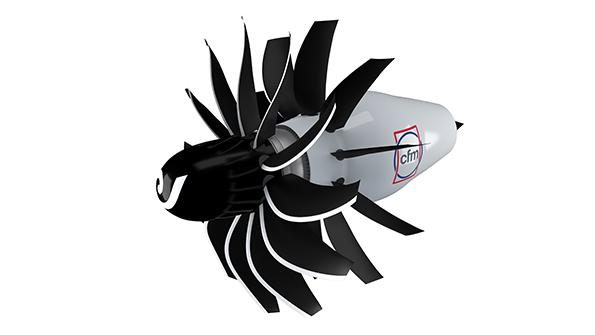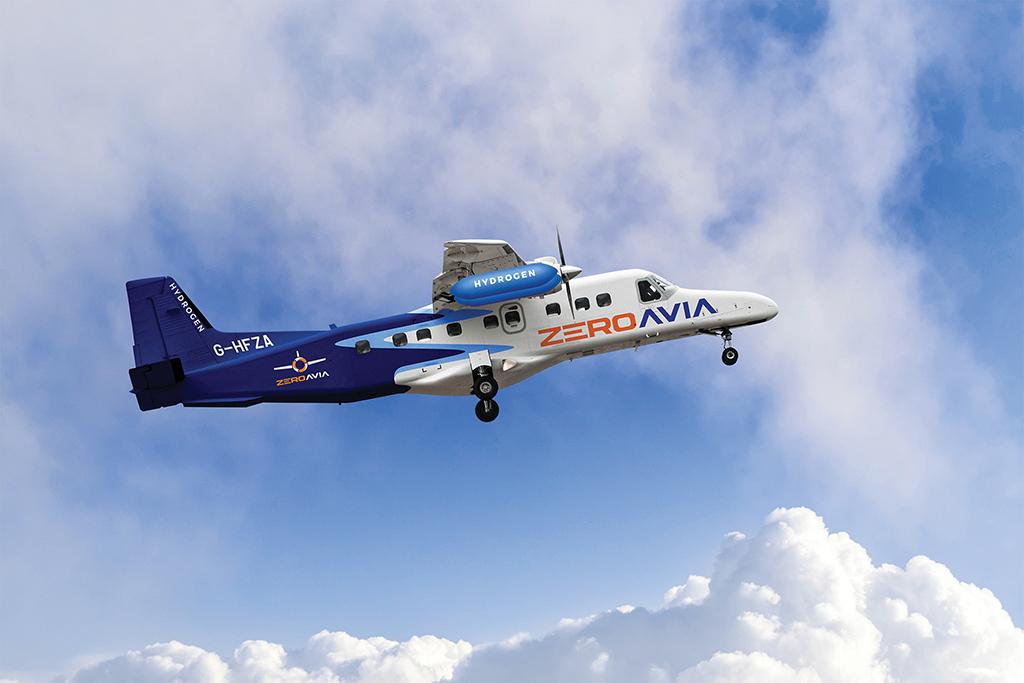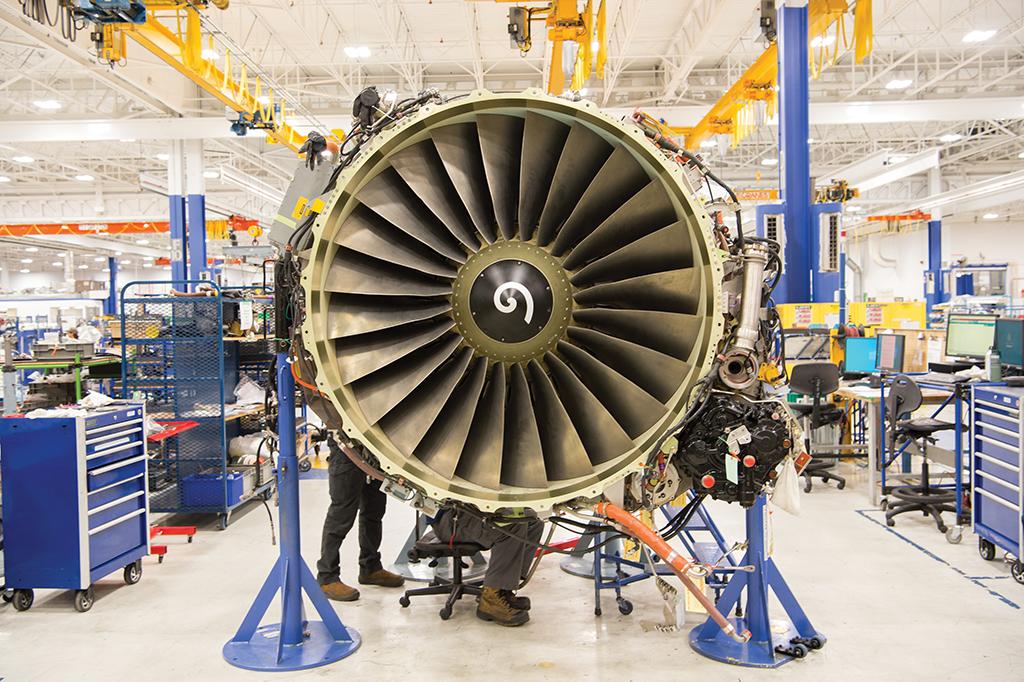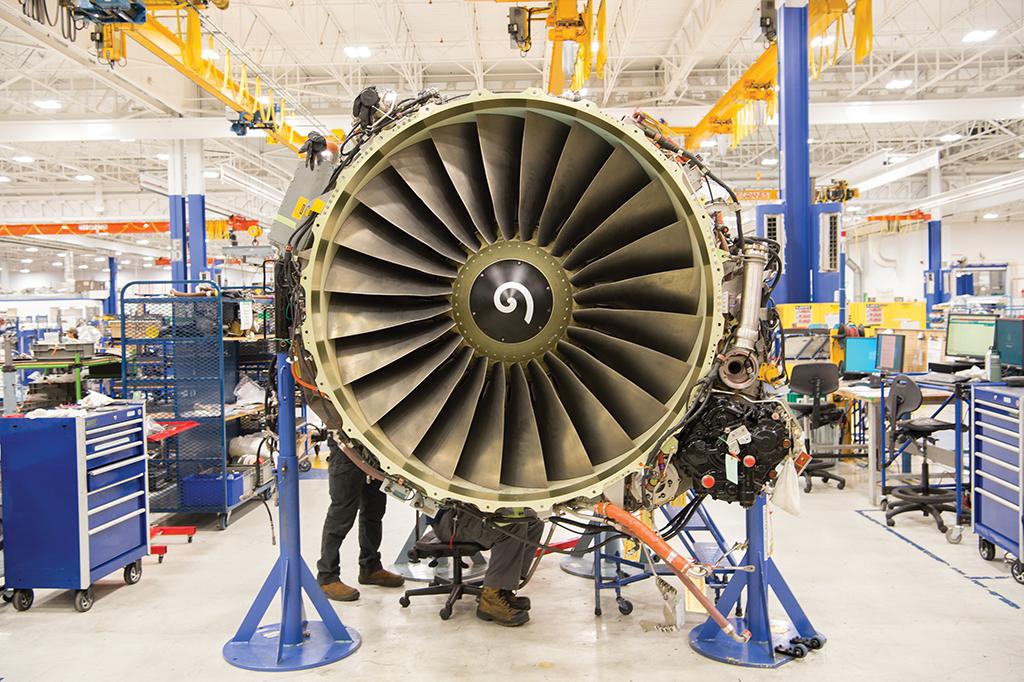Upheaval In Engine MRO: Gearing Up For Change

A confluence of technological and market changes could disrupt the aircraft engine market. To understand the shifts, we dissect key factors, including OEMs’ latest powerplant engineering plans, advances in electric and hydrogen propulsion, the aftermarket’s recovery and changes in the leasing market.
OEMs’ Bold Designs
Signs that upheaval in propulsion system technology is on the way are increasing across the power spectrum, from large- and medium-thrust turbofans to regional turboprops.
While none are expected to be ready for prime time before 2025, the pace of development—backed by growing international pressure to reduce aviation’s environmental impact—means that airline engineering and MRO managers will soon be forced to consider long-term plans for how to maintain and repair engines incorporating a coming wave of innovations.
For mainline operators, the focus is on supporting the gradual spread of gear-driven turbofans into the single-aisle fleet and being prepared for scaling up this technology as Airbus and Boeing study prospects for twin-aisle reengining later in this decade. Pratt & Whitney’s push to upgrade the PW1000G is paralleled by Rolls-Royce’s continuing drive to demonstrate and develop the geared UltraFan family for narrowbody and widebody applications into the 2030s and beyond.

However, it was the announcement this year by General Electric/Safran joint venture CFM that it plans to develop an open-rotor concept that confirmed the industry’s broader sea change toward the adoption of gear-driven turbofans. Although technologically the highlight of CFM’s Revolutionary Innovation for Sustainable Engines (RISE) program, the development of a single-stage fan paired with active stators, it is the bundle of supporting features—including a geared fan-drive system—that is causing a stir among the other engine-makers.
The open-rotor puller, or tractor, configuration—a design never previously tested at full scale—will incorporate a rotor more than 12 ft. in diameter. But the gear system required for the rotor will just as easily support a conventional ducted fan. It is clearly possible that CFM may opt for a gear-driven turbofan to succeed the Leap 1 should the technology and certification-related hurdles of the open fan become too great to overcome.
Targeting a 20% reduction in fuel consumption and CO2 emissions compared to current engines, RISE is aimed at a next-generation engine in the 20,000-35,000-lb.-thrust class. RISE will also include the development and testing of multiple new combustor designs to ensure future compatibility with sustainable aviation fuels (SAF) and liquid hydrogen.
By including both SAF and hydrogen-capable combustor designs, the technology demonstration program supports the differing future fuel strategies adopted by Airbus and Boeing. Hydrogen fuel is now a central plank of Airbus’ planning for its next-generation regional and single-aisle designs, while Boeing has committed to certifying its product line to operate on 100% SAF by 2030.
The demonstrator will also be configured with motor-generators to enable it to be adapted to hybrid-electric operation. This parallels similar development paths underway at Pratt & Whitney and Rolls-Royce, both of which are pursuing more electric power options for future turbofans.
Electricity and hydrogen are also increasingly on the agenda in the regional airline sector, which over the past year has become a key driver of propulsion innovation. Some operators and manufacturers are signing up for conversions of turboprops to hydrogen-electric powertrains, while others are waiting to see results from an ambitious hybrid-electric turboprop demonstrator plan underway with Pratt & Whitney Canada (P&WC) and De Havilland Aircraft of Canada.
Electrification and MRO
Long-term, the electrification of aircraft propulsion could reshape the MRO industry, since electric drives require far less maintenance than gas turbines. But in the near to medium term, the technology could drive a wave of business for MRO providers as aircraft are retrofitted with hybrid-electric and hydrogen-electric power-trains to reduce emissions and operating costs.
The pioneers of these new propulsion technologies are largely startups, not aircraft manufacturers or modifiers, and they are looking to partner with companies that can help them obtain supplemental type certificates (STC) for retrofits as their first and fastest route to market.

All-electric, hybrid-electric and hydrogen-electric retrofit projects have been launched for several widely used short-haul regional aircraft, as they are within reach of the capabilities provided by available battery and fuel-cell technology developed for the automotive industry. They include the ATR 42/72, Britten-Norman Islander, Cessna Caravan and De Havilland Canada DHC-6 Twin Otter and Dash 8.
All-electric aircraft will achieve the greatest reductions in maintenance, but their payload and range are limited by battery technology. Hybrid-electric systems offer greater range but have internal-combustion or gas-turbine engines at their core, so they still burn fuel and emit CO2 and NOx. These engines are able to run continuously at their optimum operating point, however, increasing efficiency and reducing wear and tear from throttle transients.
Hydrogen-electric powertrains emit no CO2 or NOx, only heat and water vapor, but while fuel cells are relatively simple, the infrastructure required to provide hydrogen supply, air compression and thermal and water management will be more complex and likely drive maintenance requirements.
Early in August, hydrogen fuel-cell propulsion startup Universal Hydrogen (UH2) teamed with experienced aerospace engineering company AeroTEC to establish a hydrogen aviation test and service center at AeroTEC’s fight-test facility at Moses Lake, Washington. UH2’s supplier partners MagniX, for the electric drives, and Plug Power, for the fuel cells, are also involved.
AeroTEC will lead conversion, flight testing and certification of the Dash 8 regional turboprop to hydrogen-electric propulsion. Conversion work for U.S. airlines as well as continued airworthiness support will be based at Moses Lake. Retrofitted Dash 8-200/-300s are planned to enter service in 2025, and UH2 has letters of intent from Ravn Alaska and Icelandair Group.

Spain’s Air Nostrum has signed a letter of intent with UH2 to convert ATR 72s to hydrogen-electric propulsion. A conversion partner for ATR-family regional turboprops has yet to be named. UH2 is developing a hydrogen logistics system for aviation and is developing retrofit kits to kickstart demand for its modular hydrogen capsules.
Electric-propulsion startup MagniX previously worked with AeroTEC to convert a 208B Caravan to all-electric propulsion, flying the proof-of-concept aircraft from Moses Lake in May 2020. MagniX is now selecting local partners to obtain STCs for the eCaravan retrofit in different regions, beginning with Sydney Seaplanes and Dante Aeronautical for the Australia, New Zealand and South Pacific region.
Los Angeles-based regional air travel provider Surf Air Mobility has ordered 100 Caravan EXs from Textron Aviation, plus options for another 50, for conversion to nine-passenger hybrid-electric aircraft. Surf Air is acquiring startup Ampaire, which is developing a hybrid-electric propulsion retrofit for the Caravan as well as the Twin Otter.
ZeroAvia has begun ground-testing a 600-kW hydrogen-electric power-train. The ZA-600 fuel-cell propulsion system is sized to replace turboprops in 10-seat single-engine and 20-seat twin-engine regional aircraft and Zero-Avia has acquired two Dornier 228s as testbeds. The first is planned to fly this year at the startup’s UK base in Kemble, England. ZeroAvia has also begun development of a 2-megawatt hydrogen-electric powertrain for 40-80-seat regional airliners.
Aircraft used for island-hopping services are another early target for electrification because of the short ranges involved. The widely used nine-passenger Britten-Norman Islander is to be converted to hydrogen fuel-cell propulsion under the UK government-supported Project Fresson led by Cranfield Aerospace Solutions. The conversion was originally planned to be hybrid-electric but was switched to fuel cells in March because batteries were too heavy. A demonstrator is planned to fly by September 2022.
British Columbia’s Harbour Air Seaplanes, which operates services to islands in the Pacific Northwest, has teamed with MagniX to obtain an STC for retrofit of the De Havilland Canada DHC-2 Beaver to all-electric propulsion. Harbor Air and MagniX have been flying a prototype eBeaver since December 2019. Switzerland’s H55 has joined the program as battery supplier. The partnership could lead to other STCs.
Adopting an alternative route to lower emissions, P&WC has revealed plans to work with De Havilland to develop a hybrid-electric-propulsion demonstrator based on the Dash 8-100. The C$163 million ($129 million) project targets the start of flight tests in 2024 and is a successor to Project 804, an earlier hybrid demonstrator plan that was subsequently sidelined. Ground testing is targeted for 2022.
Under the project, one of the aircraft’s standard PW121 turboprops will be replaced with a megawatt-scale hybrid-electric powertrain. The Collins-developed electric motor and controller will be powered by a turbogenerator and a battery system. Pratt & Whitney is targeting a 30% reduction in fuel burn and CO2 emissions compared to a modern regional turboprop airliner.
From these niche applications, propulsion electrification and hybridization are expected to expand to larger aircraft as technology advances.
While the long-term implications for the MRO market could prove profound, in the nearer term the aftermarket could have a key role in the transformation.
Will There be Enough Parts?
While the technology transformation is underway, airline activity is ramping back up as well, which means engine MRO providers are adjusting accordingly. For some, the recovery’s pace is a pleasant, if challenging, surprise.
“We had expected to see, as we have historically, that kind of six-month delay with aftermarket recovery tracking [behind] revenue passenger mile (RPM) recovery,” Raytheon Technologies President and CEO Greg Hayes says. “That’s obviously not the way we’ve seen it play out this year. . . . There’s a lot of pent-up demand. And I expect we will see the aftermarket pretty much be line-on-line with RPM growth here over the next couple of years as we see that recovery.”
For Raytheon subsidiary Pratt & Whitney, the ramp-up is filling idle shop space. “We’re still facilitized to do 1,000 V2500s [annually] if we saw that kind of a ramp,” Hayes says. “This year, we’ll probably do 550 V2500 overhauls, but the capacity still exists. It’s the same on the [PW1100G geared turbofan], and it’s really the same across the Collins portfolio. We haven’t closed factories, and we can bring folks back. We can work extra shifts to pick up on the demand. So I’m not actually worried.”
GE Aviation has seen flight activity by GE and CFM engines steadily recovering since the middle of the second quarter. While still down about 25% in July compared to two years ago across the board and varying significantly by region, the general increases are driving more maintenance spending.
“Shop visit volume trended better than our expectations, up over 30%” year-over-year, GE Chief Financial Officer Carolina Dybeck Happe said during the company’s second-quarter earnings call. Work scopes improved “slightly” compared to the first quarter, she added.
The company’s spare parts rate—commercial spares shipped out or used in GE-provided time-and-materials shop visits expressed in millions of dollars in sales per day—increased as well. The second quarter’s $15 million/day figure was up compared to the first quarter’s $13.2 million/day and second-quarter 2020’s $13.1 million/day. Pre-pandemic, the figure was around $30 million/day.
As long-haul traffic recovers, the figure should rise steadily as more lucrative widebody work picks up.
“Broadly, we’re seeing a higher concentration of narrowbody visits, which typically have lower revenue,” she added.
GE is projecting a sequential improvement in shop visits in the third quarter and a 25% increase compared to the third quarter of 2020.
“I think our view is that we will continue to see strong year-over-year shop visit numbers,” CEO Larry Culp says. “I think we’ll see a gradual continuation of the improvement sequentially as well. That suggests a number of these impediments, like green time, fade with time, but they don’t disappear.
“We’re obviously watching some other variables here like the [COVID-19] delta variant,” Culp added. “But at this point, I think we’re optimistic about the second-half performance in aviation services.”
Culp says GE Aviation, which announced plans last year to cut 25% of its global workforce, is working to match anticipated demand with its shop capacity.
“We’ve laid in place plans that will give us an opportunity to ramp back effectively from a safety, from a quality, from an on-time delivery perspective, but also to have the right cost structure along the way,” he says. “We will be dealing with limits in terms of our shop visit capacity in a particular window. That’s part of the conversation we’re already having with customers as they begin to think about the second half of ’21,” he adds. “They want to make sure that they have their fleet in tip-top, ready-to-go condition.”
As increasing flight activity boosts maintenance, engine service providers will have to make do without a key source of parts—at least for a while. Used serviceable material (USM) remains scarce on many popular platforms—think narrowbodies and some older widebody engine types seeing a resurgence with increased freighter flying activity—due to a combination of factors (see sidebar, page MRO11).
Some airlines are postponing permanent retirement decisions, hoping to gauge the recovery’s pace and shape just in case some idled lift is needed. In other cases, airlines are holding onto assets they do not plan to reactivate but are not seeing prices high enough to justify sales and related balance-sheet adjustments.
As a result, aftermarket providers are purchasing fewer used parts than at any time since the global traffic downturn started in early 2020—a clear sign that the aircraft-retirement stalemate is affecting USM supply, a Canaccord Genuity analysis found.
Respondents to Canaccord’s most recent quarterly aftermarket survey, conducted in early July, reported sourcing 13% of their parts from the USM market in the second quarter. The figure matches first-quarter 2018 and second-quarter 2019 for the lowest in more than three years and is a 10% drop from the first quarter of 2021.
“We believe that the drop in USM purchasing points more to the lack of supply rather than a slowdown in demand,” Canaccord analyst Ken Herbert wrote in a related research note recently. “In fact, we believe purchasing of alternative material”—including both parts manufacturer approval material and USM—“will accelerate faster than [original equipment] parts purchasing as the recovery gains traction.”
However, the lack of USM combined with planned production-rate ramp-ups by both Airbus and Boeing in the next year or so could put additional pressure on the supply chain. Engine manufacturers, which have a major stake in both building and maintaining engines, are keeping a close eye on the supply chain to ensure both sides of their business will keep pace during the recovery.
Safran keeps 700 companies, which is a portion of its entire supply chain, under extra scrutiny, CEO Bernard-Pierre Delpit explains. “We think that there are, let’s say a bit more than 100, less than 150, which are in a situation that need really to be managed,” he told analysts during the company’s most recent earnings call. “We haven’t seen a lot of suppliers really turning into a very bad shape. A handful have experienced a critical situation. So we don’t see that as a burning issue.”
As Safran makes plans to ramp up production while keeping up with the existing fleet’s growing maintenance needs, it is taking a hands-on approach to ensure all its suppliers are prepared.
“We made across-the-board inquiries to be sure that they are ready, that they have all means—from a cash point of view, from a headcount point of view—to ramp up again,” Delpit said. “Today, I don’t have [the supply chain] on my agenda as a bottleneck for the ramp-up in the near term.”
State of Engine Leasing
The engine overhaul market was hit hard during the pandemic, and a consequence of the crisis has been carriers renegotiating existing engine leasing agreements. Going forward, an increase in the number of short-term lease agreements between lessors and airlines is expected and will likely pick up further over the next 12-18 months. At Aviation Week’s recent Engine Leasing Trading and Finance virtual event, Tadhg Dillon, senior vice president and head of sales at Shannon Engine Support, said: “Airlines will most likely lease engines instead of actually spending large amounts of money on shop visits. It’s cheaper from a cash perspective in the short-term.”
Green-time engine requests from airlines are also gradually increasing as carriers look to prevent spending what they deem to be unnecessary money on engine shop visits. As flying restrictions lift and passenger numbers increase, this demand is expected to pick up pace, particularly for engines powering narrowbody and regional aircraft. Consultancy ICF International says many V2500s still remain on lease, and demand for green-time V2500 engines has picked up.
The V2500’s traditional competitor, the CFM56-5B, is set to recover at a slower pace due to current oversupply in the market because of excess Airbus A320ceos that are parked. Demand for the CFM56-7B variant is expected to recover by late 2021/early 2022, having slumped during the pandemic.
Given the pricing structures and the increased availability of certain engine types from lessors, the market in 2021 is a favorable one for lessees. Kenya Airways, for example, revealed that pricing on certain assets is sometimes half what it was compared to pre-COVID-19 times. Some carriers are expected to become more active in buying up used engines and parts in addition to burning green-time engines.
The boom in the cargo market over the past year will also be reflected in increased lease demand for the PW4000. Traditionally an engine found on mature widebody platforms such as the Boeing 747, 777 and the Airbus A330, it will likely see longevity as an engine used for freighters.
Consolidation of the market will likely to continue as lessors seek to add volume in the aftermath of the COVID crisis, too. ICF International expects “one or two” large-scale deals to close this year, one of which will likely be the $30 billion mega-merger between AerCap and GECAS. Carlyle Aviation’s acquisition of Fly Leasing is also expected to close later this year. For market analysts, investor confidence in the engine leasing market is likely to reflect any upturn in passenger confidence and volumes moving in an upward trajectory.
Lease or Teardown?
Increased narrowbody flying has pushed leasing prices for engines powering those aircraft higher in the last several months. With the market demand high for used serviceable engine material, what is the tipping point for making an engine such as the CFM56 a leasing or teardown candidate?

As a rough guide, “the market sweet spot tends to be 7,000-10,000 cycles remaining for life-limited parts, so a module with those cycles remaining will be a candidate for tear down,” says Michael Lindsay, head of USM programs for FTAI Aviation, a subsidiary of Fortress Transportation and Infrastructure Investors.
FTAI leases any engine that is tagged serviceable, but once it is unserviceable, FTAI takes a modular approach to it. For example, “on a single unserviceable engine, we can tag the fan module serviceable, overhaul the core module and disassemble the LPT module,” Lindsay says.
He says he has recently seen a “strong increase in engines going to teardown, as evidenced by stiff competition for shop induction slots with availability out as far as several months.” To meet upcoming engine demand, FTAI has disassembled 20 engines so far this year but could disassemble as many as 40 with partner AAR.
The CFM56 is by far the most prevalent engine family flying today (see chart below).









Comments